The red snapper is among the most popular bottom species for recreational fishermen in the southern states. They are found from South Carolina to Florida and throughout the Gulf of Mexico, and if you’ve ever hooked into one, you know they are one tough customer. Beautiful, strong, fast and a challenge to catch, the final reward of a successful day of fishing is the feast they provide on the dinner table.
Captain George Mitchell, Yamaha’s lead pro staff member, has decades of experience targeting red snapper as an avid angler and professional charter captain. He has fished extensively on the South Atlantic coast and throughout the Gulf of Mexico and red snapper is a favorite target species. His current home base on the Florida Panhandle is near Mexico Beach, considered by many to be the red snapper capitol of Florida. This is due to the extensive artificial reef system that is ideal red snapper habitat. We asked George to share some of his extensive knowledge on the subject and what follows is some of the best advice for novice anglers who want to catch their first red snapper and for experienced anglers who want to fine tune their game.
“I’ve caught red snapper as far north as the Carolinas, off the entire east coast of Florida, in the Keys, Dry Tortugas, off the west coast of the state and throughout the Gulf all the way to Texas,” says Mitchell. “They are a structure-oriented species and that makes them a little easier to find. While they will eat a wide range of baits and hit lures, most of their diet consists of crustaceans, and that’s why they live on and around hard structure. I’ve caught them in water as shallow as 25 feet in bays, but they typically don’t live in shallow areas because of the variability of salinity. They are true saltwater fish, not estuary dwellers. They will migrate there when conditions are right, and forage is available but move off just as quickly. Most red snapper spots fall between 50 and 120 feet, what I call the sweet spot, but I have caught them on structure as deep as 220 feet.”
George told us that artificial reefs and other manmade structures including sunken ships and shrimp boats that can be found throughout the Gulf are all ideal red snapper spots. Near his home, the Mexico Beach Artificial Reef Association (MBARA) has been responsible for deploying over three hundred carefully located reefs that include sunken barges, cable reels, concrete rubble and specialized structures constructed specifically for reefing that are quickly colonized by sea life and that become home to red snapper and other structure dependent fishes.
“I love artificial reefs, they are incredibly productive,” Mitchell says. “But natural bottom features can be equally or even more productive. Those can include cracks, ledges, corals, potholes, any type of live hard bottom. By live, I mean bottom that provides a foothold for barnacles and other critters that live attached to hard structure. Those places in turn attract shrimp, crabs, lobsters and other crustaceans that red snapper love to eat.”
The location of potentially productive red snapper structure can be found on electronic fishing charts created for onboard chart plotters. For example, Navionics® fishing charts provide detailed bathymetric features that clearly show areas of rapid depth changes and in fishing mode include the location of many wrecks and known artificial reef sites. Most coastal states have websites that provide detailed charts of artificial reefs located off their coasts, and organizations like MBARA publish the locations of the reefs it creates on its website. All this available data can make finding manmade and natural structure where red snapper can be found simple.
“I check for updates on artificial reef sites, so I know about any new deployments near my home waters, and if I am trailering my boat to more distant locations either within Florida or the surrounding states, I check those websites, too. I probably have over a thousand productive bottom spots logged into my chart plotter because they don’t just make good places to fish for snappers but are also great for predators like kingfish,” George advised. “Just be aware that most snappers including the reds can move from location to location so they might not always be on a specific structure spot. That’s why I always have a game plan before I leave the dock.”
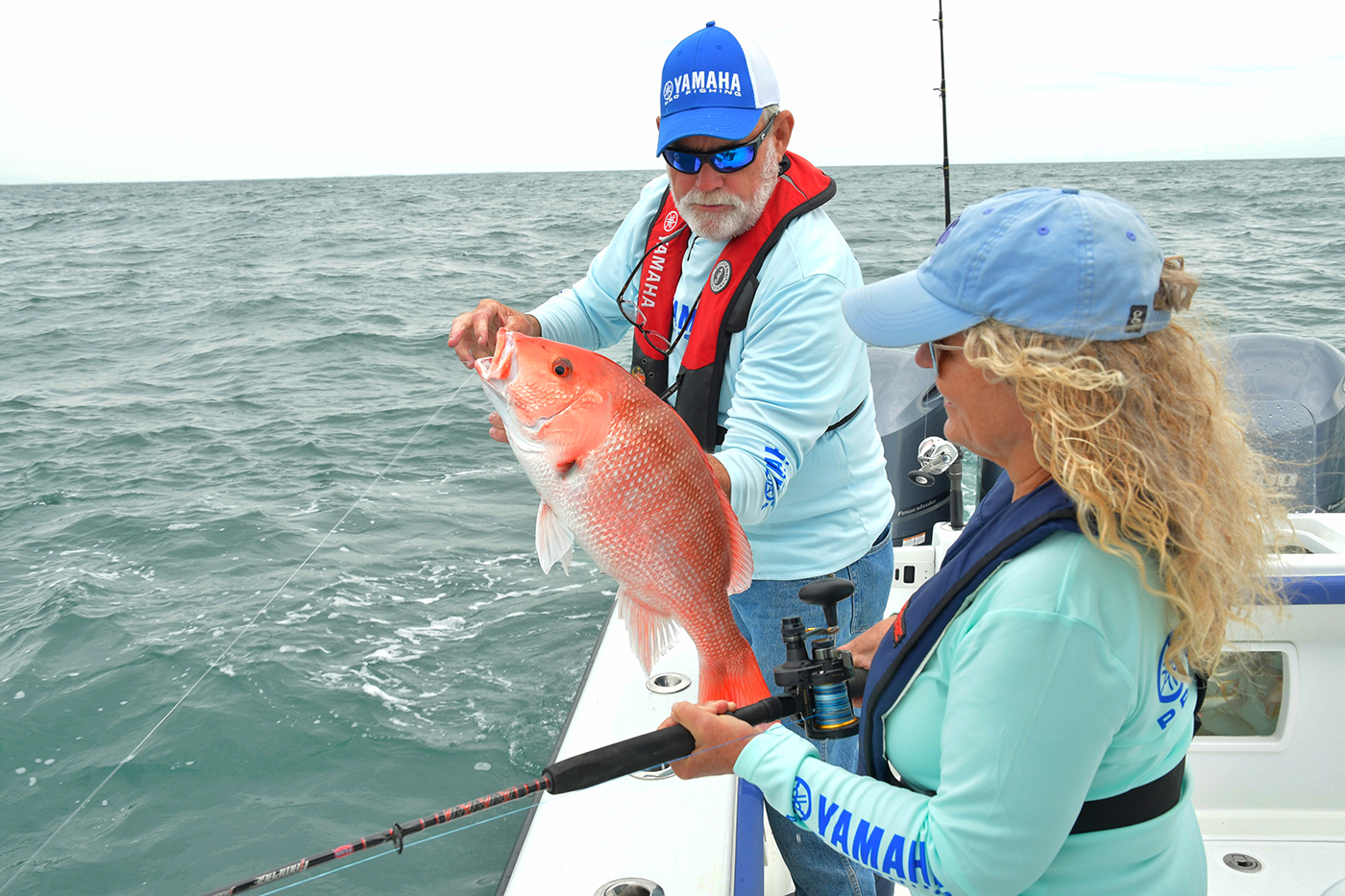
By game plan, George means he will have a series of spots he will target that day. He will begin with known productive structure in a specific depth range. If that doesn’t pan out, he will go to Plan B, which might be nearby structure deeper or shallower and if that doesn’t produce, he can go to Plan C and so on. For example, when he lived on the east coast of Florida, he would fish out of Port Miami regularly.
“My game plan for the day might be to first head to the Almirante wreck, a large ship sunk as an artificial reef. If the fish weren’t there or if there were too many boats fishing the wreck, my next stop would be to head slightly inshore to a long natural ledge nearby and work that area. If that wasn’t happening, my next stop might be the deep side of the coral reef that runs along the coast, or another wreck about ten miles away. Having a game plan keeps you from running all over the ocean and helps focus your efforts.”
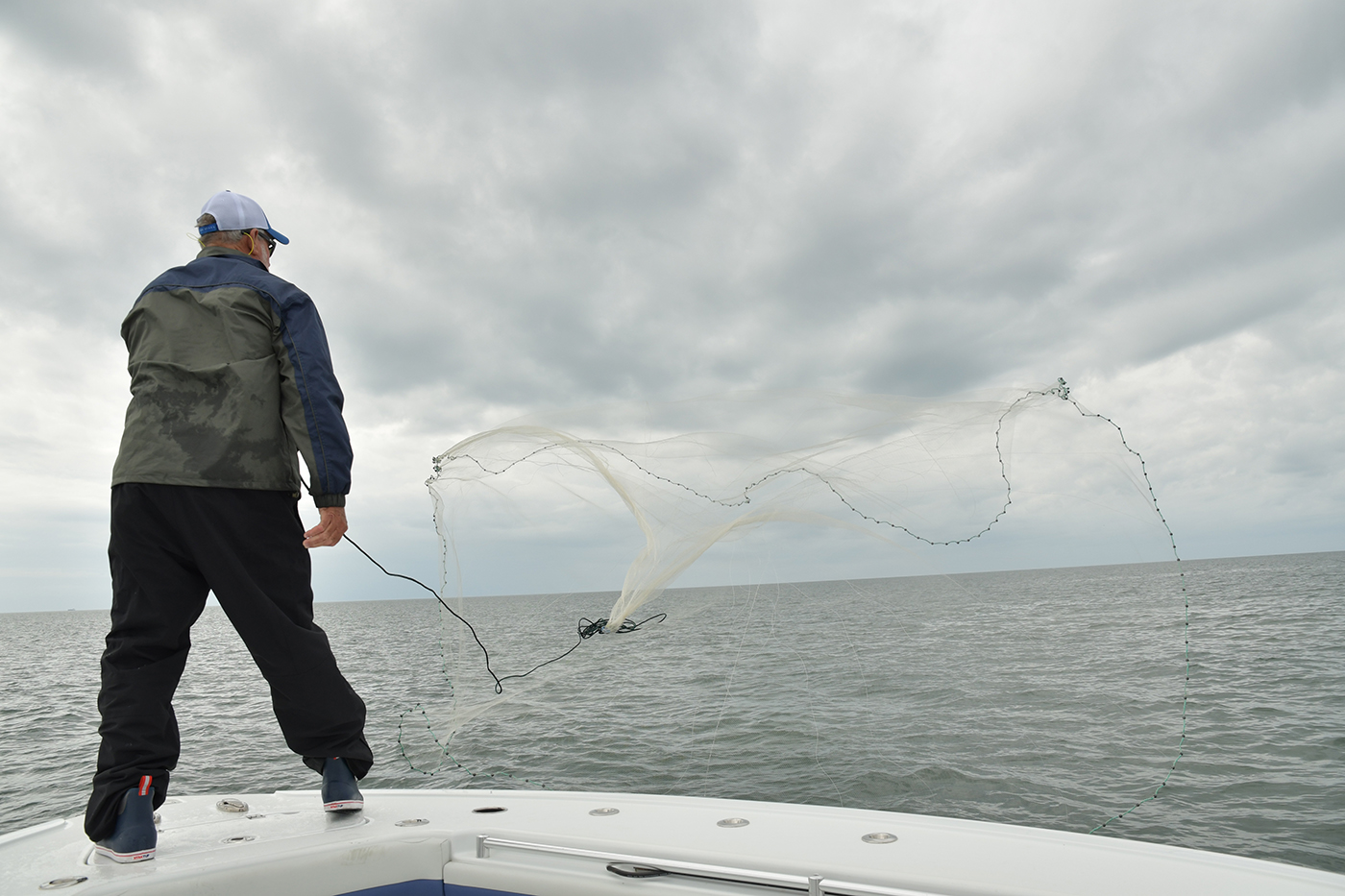
“Tackle for red snapper can vary with the water depth being fished,” George says, “but the most important thing you have to understand is that every fight is won or lost in the first inning. Your tackle has to be heavy enough to prevent the fish from running back into the structure which results in a zing-pow, a broken line and lost fish.”
George explained that when targeting relatively shallow structure, less than 50 feet or so, the boat should be positioned up current of the structure, and the typical snapper will rarely be over ten pounds. A 5000 series spinning reel loaded with 30 or 40-pound test braid and a top shot of 50-pound fluorocarbon leader will do the job. You can cast to get close to the structure and when you get a bite pull the fish back towards the boat away from it. When fishing on deeper structures you can position the boat over the structure and fish in a more vertical manner. Here, George’s preference is for a heavier conventional outfit like a graphite lever drag reel with 50 or 65-pound braid and a heavier top shot with a medium-heavy rated jigging rod. With that tackle you can crank the fish up away from the structure to prevent being broken off.
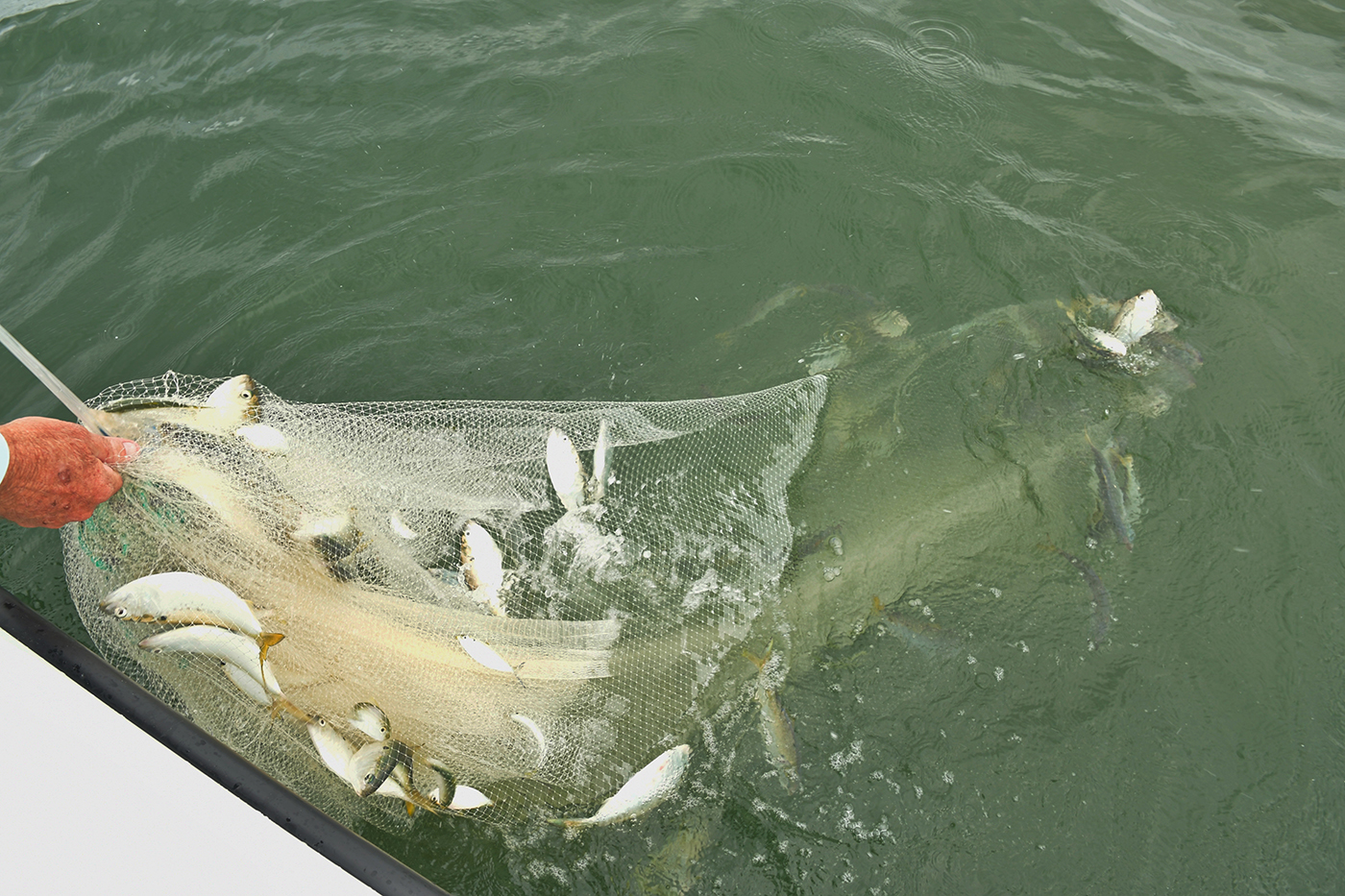
“I love modern conventional reels and one of my favorites is the Penn Fathom™ graphite frame series with a lever drag,” he says. “They can pump out serious drag pressure and have a fast retrieve which makes cranking the fish away from where they want to go more successful. In deeper water you are also more likely to encounter much bigger red snappers, fish that can top 25 or 30 pounds and they are a handful. For moderately deep water I use the Fathom 15 or 20 size and go even larger when fishing 150-foot depths.”
George said his favorite live bait for red snapper is a pinfish. Easy to catch, easy to keep alive and snapper love them, but there are many choices. Sardines and cigar minnows, either alive or dead will get eaten as will small frozen whole squid or large squid strips. Pogies (menhaden) make good bait and chunks cut from fresh bonito, pogies and even ballyhoo will work. Chum made from menhaden can help bring fish away from the structure and closer to the surface and hooking them out in the open tilts the odds of catching them greatly in your favor. It also helps prevent a passing shark or goliath grouper from stealing your snapper before you can get it in the boat.
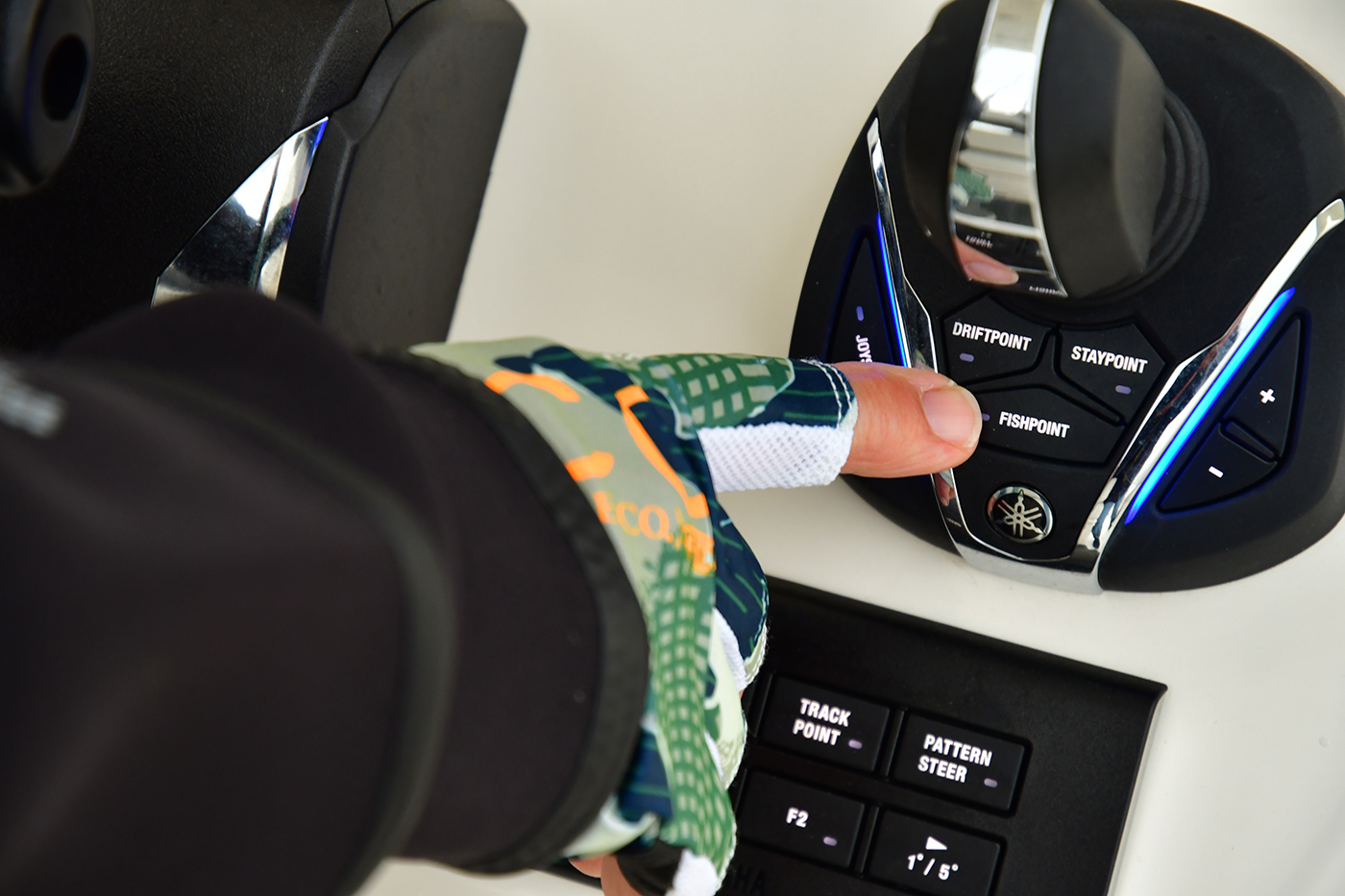
“We’ve had some success using artificial lures like slow pitch jigs, bucktails and plastic tail jigs for red snapper but it’s hard to beat the real thing whether its dead or alive. These fish have a sensitive scene of smell and natural baits fit the bill in that department,” Mitchell says.
One of the most important factors for a successful outing for red snapper is boat positioning. Back in the old days, which was accomplished using anchors with chain and rope to get into position and hold there. If the prevailing current or wind changes the boat will drift off the spot and require moving the anchor. Getting on a small piece of structure with only an anchor can be a daunting task. George has been on the forefront of the revolutionary Yamaha Helm Master® system since its inception and over its evolution into the incredible Helm Master EX, today.
“Helm Master EX is a total game changer,” Mitchell says with a certain bit of pride. His involvement with the engineers and computer technicians that built it is reflected in the systems fishing capabilities. George knew what he wanted the system to do and was able to show and explain it in great detail to the technical wizards that made it happen.
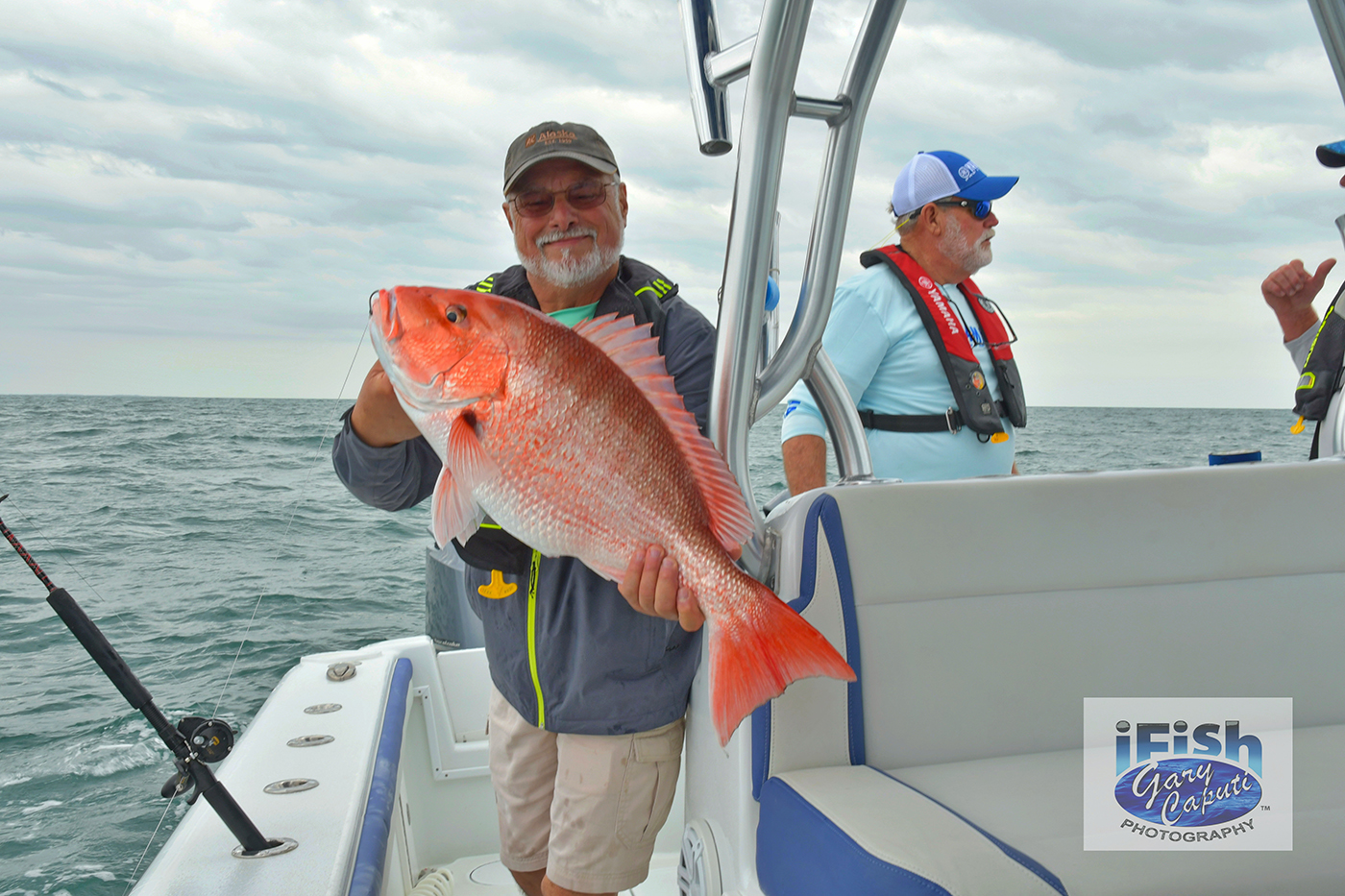
“Forget about anchors, with the Yamaha Helm Master EX boat positioning is far more accurate and adjustable than ever before,” he continued. “Remember, for red snapper we want to position the boat up current of most structure, especially shallow structure. I always start with what I call a “benchmark drift” over the structure. When you get to a likely spot, stop and let the boat drift with the engine in neutral for a few minutes and watch the plot trail on your chart plotter. Then reposition the boat up current from the structure and do the drift again, only this time over the structure. These maneuvers will show me how the boat will sit against the current and where to position the boat while also giving me a chance to see where the fish are holding on the structure, which is usually on the up current side.
“With the Helm Master system preset for FishPoint Stern I run the boat over and past the structure into the current, turn it so the transom is facing away from the structure and engage Helm Master. In FishPoint® Stern the system will automatically control the steering and engine speed in reverse to hold the boat bow toward the structure so you can drop or cast your baits, so they fall toward the up current side. Now here’s the beauty of the system. Your baits are running forward away from the engines which are holding the boat in position in reverse. If you think you’re too close or too far away from the structure you can move the boat in ten-foot increments forward, backward, or to either side by simple clicking the joystick in the direction you want to move. Each additional click adds ten more feet and will be GPS precise. For boat positioning for bottom fishing nothing else even comes close, it’s priceless!”
The same holds true when fishing for red snapper in deeper water where you are fishing in a more vertical fashion. Using the boat in FishPoint Stern or in StayPoint® in a multi-engine installation, it will hold the boat in the exact position you want even if the wind and current change in direction or speed. The system’s integrated GPS, heading sensor and computer learn the sea conditions and automatically adjust the engine(s) speed and steering accordingly. If the fish aren’t on the up current side of the structure, you can easily move around it with the joystick and stop over the fish you mark on your depthfinder and start fishing again.
We’d like to thank Captain George for all the great advice. His insights into red snapper fishing will go a long way toward making your first trip or your hundredth trip more successful.
Back to Blue Life
Captain George Mitchell, Yamaha’s lead pro staff member, has decades of experience targeting red snapper as an avid angler and professional charter captain. He has fished extensively on the South Atlantic coast and throughout the Gulf of Mexico and red snapper is a favorite target species. His current home base on the Florida Panhandle is near Mexico Beach, considered by many to be the red snapper capitol of Florida. This is due to the extensive artificial reef system that is ideal red snapper habitat. We asked George to share some of his extensive knowledge on the subject and what follows is some of the best advice for novice anglers who want to catch their first red snapper and for experienced anglers who want to fine tune their game.
“I’ve caught red snapper as far north as the Carolinas, off the entire east coast of Florida, in the Keys, Dry Tortugas, off the west coast of the state and throughout the Gulf all the way to Texas,” says Mitchell. “They are a structure-oriented species and that makes them a little easier to find. While they will eat a wide range of baits and hit lures, most of their diet consists of crustaceans, and that’s why they live on and around hard structure. I’ve caught them in water as shallow as 25 feet in bays, but they typically don’t live in shallow areas because of the variability of salinity. They are true saltwater fish, not estuary dwellers. They will migrate there when conditions are right, and forage is available but move off just as quickly. Most red snapper spots fall between 50 and 120 feet, what I call the sweet spot, but I have caught them on structure as deep as 220 feet.”
George told us that artificial reefs and other manmade structures including sunken ships and shrimp boats that can be found throughout the Gulf are all ideal red snapper spots. Near his home, the Mexico Beach Artificial Reef Association (MBARA) has been responsible for deploying over three hundred carefully located reefs that include sunken barges, cable reels, concrete rubble and specialized structures constructed specifically for reefing that are quickly colonized by sea life and that become home to red snapper and other structure dependent fishes.
“I love artificial reefs, they are incredibly productive,” Mitchell says. “But natural bottom features can be equally or even more productive. Those can include cracks, ledges, corals, potholes, any type of live hard bottom. By live, I mean bottom that provides a foothold for barnacles and other critters that live attached to hard structure. Those places in turn attract shrimp, crabs, lobsters and other crustaceans that red snapper love to eat.”
The location of potentially productive red snapper structure can be found on electronic fishing charts created for onboard chart plotters. For example, Navionics® fishing charts provide detailed bathymetric features that clearly show areas of rapid depth changes and in fishing mode include the location of many wrecks and known artificial reef sites. Most coastal states have websites that provide detailed charts of artificial reefs located off their coasts, and organizations like MBARA publish the locations of the reefs it creates on its website. All this available data can make finding manmade and natural structure where red snapper can be found simple.
“I check for updates on artificial reef sites, so I know about any new deployments near my home waters, and if I am trailering my boat to more distant locations either within Florida or the surrounding states, I check those websites, too. I probably have over a thousand productive bottom spots logged into my chart plotter because they don’t just make good places to fish for snappers but are also great for predators like kingfish,” George advised. “Just be aware that most snappers including the reds can move from location to location so they might not always be on a specific structure spot. That’s why I always have a game plan before I leave the dock.”

By game plan, George means he will have a series of spots he will target that day. He will begin with known productive structure in a specific depth range. If that doesn’t pan out, he will go to Plan B, which might be nearby structure deeper or shallower and if that doesn’t produce, he can go to Plan C and so on. For example, when he lived on the east coast of Florida, he would fish out of Port Miami regularly.
“My game plan for the day might be to first head to the Almirante wreck, a large ship sunk as an artificial reef. If the fish weren’t there or if there were too many boats fishing the wreck, my next stop would be to head slightly inshore to a long natural ledge nearby and work that area. If that wasn’t happening, my next stop might be the deep side of the coral reef that runs along the coast, or another wreck about ten miles away. Having a game plan keeps you from running all over the ocean and helps focus your efforts.”

“Tackle for red snapper can vary with the water depth being fished,” George says, “but the most important thing you have to understand is that every fight is won or lost in the first inning. Your tackle has to be heavy enough to prevent the fish from running back into the structure which results in a zing-pow, a broken line and lost fish.”
George explained that when targeting relatively shallow structure, less than 50 feet or so, the boat should be positioned up current of the structure, and the typical snapper will rarely be over ten pounds. A 5000 series spinning reel loaded with 30 or 40-pound test braid and a top shot of 50-pound fluorocarbon leader will do the job. You can cast to get close to the structure and when you get a bite pull the fish back towards the boat away from it. When fishing on deeper structures you can position the boat over the structure and fish in a more vertical manner. Here, George’s preference is for a heavier conventional outfit like a graphite lever drag reel with 50 or 65-pound braid and a heavier top shot with a medium-heavy rated jigging rod. With that tackle you can crank the fish up away from the structure to prevent being broken off.

“I love modern conventional reels and one of my favorites is the Penn Fathom™ graphite frame series with a lever drag,” he says. “They can pump out serious drag pressure and have a fast retrieve which makes cranking the fish away from where they want to go more successful. In deeper water you are also more likely to encounter much bigger red snappers, fish that can top 25 or 30 pounds and they are a handful. For moderately deep water I use the Fathom 15 or 20 size and go even larger when fishing 150-foot depths.”
George said his favorite live bait for red snapper is a pinfish. Easy to catch, easy to keep alive and snapper love them, but there are many choices. Sardines and cigar minnows, either alive or dead will get eaten as will small frozen whole squid or large squid strips. Pogies (menhaden) make good bait and chunks cut from fresh bonito, pogies and even ballyhoo will work. Chum made from menhaden can help bring fish away from the structure and closer to the surface and hooking them out in the open tilts the odds of catching them greatly in your favor. It also helps prevent a passing shark or goliath grouper from stealing your snapper before you can get it in the boat.

“We’ve had some success using artificial lures like slow pitch jigs, bucktails and plastic tail jigs for red snapper but it’s hard to beat the real thing whether its dead or alive. These fish have a sensitive scene of smell and natural baits fit the bill in that department,” Mitchell says.
One of the most important factors for a successful outing for red snapper is boat positioning. Back in the old days, which was accomplished using anchors with chain and rope to get into position and hold there. If the prevailing current or wind changes the boat will drift off the spot and require moving the anchor. Getting on a small piece of structure with only an anchor can be a daunting task. George has been on the forefront of the revolutionary Yamaha Helm Master® system since its inception and over its evolution into the incredible Helm Master EX, today.
“Helm Master EX is a total game changer,” Mitchell says with a certain bit of pride. His involvement with the engineers and computer technicians that built it is reflected in the systems fishing capabilities. George knew what he wanted the system to do and was able to show and explain it in great detail to the technical wizards that made it happen.

“Forget about anchors, with the Yamaha Helm Master EX boat positioning is far more accurate and adjustable than ever before,” he continued. “Remember, for red snapper we want to position the boat up current of most structure, especially shallow structure. I always start with what I call a “benchmark drift” over the structure. When you get to a likely spot, stop and let the boat drift with the engine in neutral for a few minutes and watch the plot trail on your chart plotter. Then reposition the boat up current from the structure and do the drift again, only this time over the structure. These maneuvers will show me how the boat will sit against the current and where to position the boat while also giving me a chance to see where the fish are holding on the structure, which is usually on the up current side.
“With the Helm Master system preset for FishPoint Stern I run the boat over and past the structure into the current, turn it so the transom is facing away from the structure and engage Helm Master. In FishPoint® Stern the system will automatically control the steering and engine speed in reverse to hold the boat bow toward the structure so you can drop or cast your baits, so they fall toward the up current side. Now here’s the beauty of the system. Your baits are running forward away from the engines which are holding the boat in position in reverse. If you think you’re too close or too far away from the structure you can move the boat in ten-foot increments forward, backward, or to either side by simple clicking the joystick in the direction you want to move. Each additional click adds ten more feet and will be GPS precise. For boat positioning for bottom fishing nothing else even comes close, it’s priceless!”
The same holds true when fishing for red snapper in deeper water where you are fishing in a more vertical fashion. Using the boat in FishPoint Stern or in StayPoint® in a multi-engine installation, it will hold the boat in the exact position you want even if the wind and current change in direction or speed. The system’s integrated GPS, heading sensor and computer learn the sea conditions and automatically adjust the engine(s) speed and steering accordingly. If the fish aren’t on the up current side of the structure, you can easily move around it with the joystick and stop over the fish you mark on your depthfinder and start fishing again.
We’d like to thank Captain George for all the great advice. His insights into red snapper fishing will go a long way toward making your first trip or your hundredth trip more successful.
